Mannavanur Lake – lost somewhere near Kodaikanal
The mist tip toed upon us , all of a sudden ,like a mysterious visitor. Wrapping everything in its fold, it moved silently around, as the forests and the mountains disappeared in front of our eyes. I squinted through the haze and gazed into what was earlier a grove of eucalyptus trees . As visibility was almost near zero, we stopped by in our journey and walked right into the mist. A pair of glassy eyes squinted through the trees , untouched by the mist . I walked towards it and found it to be an abandoned large sized soft toy – a tiger , looking like its straight out of a Calvin and Hobbes cartoon.
I am in Kodaikanal , a retreat tucked away in the Palani Hills , thronged by tourists and honeymooners all through the year. Although it is believed to have been discovered by a British missionary way back in the 19th century, it has an ageless spirit around it . Locals say that the earliest inhabitants of Kodaikanal were the Paliyan tribes, whose descendants still live near Kukal caves.
As you gaze into the green fabric laced with dense vegetation and the tall eucalyptus trees, you understand why Kodaikanal has been called the Gift of the forest. Lakes, mountains, forests, plantations , caves, waterfalls, temples, myths, legends – Kodaikanal has them all. The romantics are lured by the misty lakes and the waterfalls, while the hard core trekkers prefer the caves and the dense forests. And yet Kodaikanal is filled with tourist traps.
My guide book lists out lakes, parks and gardens. Most of the tourist attractions are still reminiscent of the colonial period. Coaker’s Walk, Bryant’s park are just some of them, while the tourists prefer to crowd over the lake in the town. “ Would you like to go to Guna’s caves ? This is where the actor Kamalahassan’s film was shot ! “ asks our host , referring to Devil’s Kitchen , the giant boulders filled with bats. “ Or maybe to Dolphin’s Nose and Pambar falls ..”
We carefully avoided the tourist traps. I asked him to suggest a small retreat which is not just beautiful, but is lost to mankind and he smiled. “ Have you been to Mannavanur ?” The name did not ring a bell. At first it just sounded like another dusty south Indian hamlet that would not even a milestone named after it. Looking at my blank face, he went into raptures of it. “ You can see a lake, some farming and even a sheep research centre ,” he added as I refused to be taken in by his salesmanship. And then he took out a picture of a sparkling lake bordered by distant mountains, lost completely to mankind. On an impulse we decided to hit the road.
The journey was enveloped by mist . We stopped by near a grove as the mist moved directionless, caressing our cheek and embracing us. We let the moments pass and then continued our journey downhill. The forests morphed into meadows and the mountains tapered down towards us with terraced farms on their slopes . The mist gave way to a drizzle as the journey took us downhill towards Munnar. The hills were getting closer as we drove down towards plains. A distant lake amidst the mountains came into view, tempting us to stop over, but we carried on . An hour later we were in our destination.
The silence was deafening. There was not a single person around. The village looked deserted for a minute. My mind had drawn its own pen pictures – a lively market scene, small shops huddled together, a local bus stand bursting with gossip, mud houses, a collage of movie posters, a small temple and shy village belles walking around it. But we could see none of these stereotypes.
Surrounded by green rolling hills with terraced fields sloping downhill, the road took us down through meadows and farms. Fresh under the spell of the rains, the greenery blinded our eyes. We walked until we found some cattle and sheep grazing in the meadows. And then our first sign of habitation – a couple of shepherds sauntered into view. We asked them about the rest of the people and they pointed to distant fields around . We chatted for a while and we continued strolling along without any particular agenda.
We walked towards the sheep research centre and although we were not given permissions to visit it, we spoke to a few locals here who gave us a peep into their idyllic lives. Mannavanur is primarily an agrarian hamlet and the slopes yielded a variety of vegetables from potatoes, broccoli, cauliflower, cabbage , beans and peas . There are hardly 600 households here and most of the people are farmers . The village had a school, a bank, a post office and a medical centre located amidst the grasslands which is unique to these areas. “You can even see wildlife here,” cautioned one of the men as we take leave .” Deer , gaur and even wilddogs , “ he added as we asked him for the directions to the lake.
We walked along intercepting small streams and waterfalls before running into an entire field of bright orange carrots. We heard some voices and followed them to find a group of men diligently washing the carrots and packing them off in sacks. The men stood on the carrots , cleaning them after the harvest. They humoured us by performing the action for our camera. At first the carrots were left lying near a small stream and then the men would do a little dance on them, rubbing them with the soles of their feet , probably kicking them a bit as well. Finally they were once again shaken and stirred as they were packed into the sacks and sold in the markets . The men told us that some of the carrots find their way into cities , while very little was left for local consumption.
And finally by following the path of a small stream, we reached our destination. A huge sparkling lake amidst all the greenery, bordered by mountains, awaited us. Reflecting the cloudy sky and the hazy forests , it flowed there unmindful of its own beauty. Words failed us as we tried to describe the moment . There is a certain lure in the still waters and we sat there for a long time, lost to the world, absorbed in our own thoughts. The butterflies came fluttering and the birds sang for us. A common kingfisher fished into the waters, while a brahminy kite scooped down . Soon the mist came calling and we decided to tear ourselves away from this piece of lost paradise.
As we retraced our steps back to Kodaikanal, I realized that the most beautiful stretches of nature are those that are virgin and untouched by man. Mannavannur is no place for revelers and picnickers . It is only reserved for the pantheists, the high priests of nature who revere nature and carry a piece of it with them wherever they go and not for those who leave a piece of themselves behind in the form of cans, bottles and plastic covers .
Getting there
Mannavanur is downhill from Kodaikanal and at a distance of 40 kms, it is little more than an hour’s drive from the hill station. There are neither proper accommodation options nor eateries around here. However there are certain camp sites close by that offer some basic accommodation. There are several trek routes that pass via Mannavanur. Kodaikanal is about 520 kms from Chennai and 135 kms from Madurai and it is also well connected by road and rail. This article was featured in Windows and Aisles, the inflight magazine of Paramount Airlines

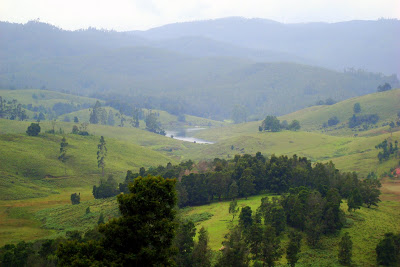
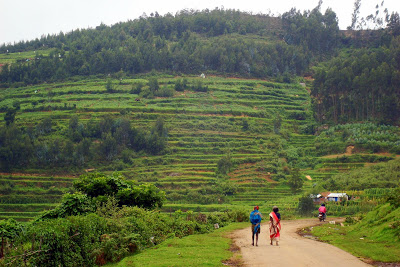
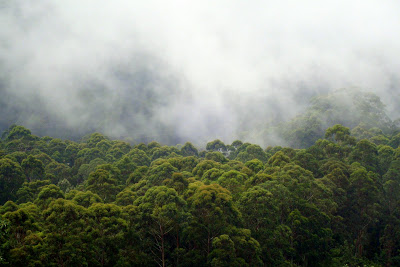
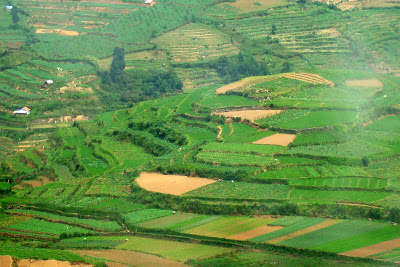
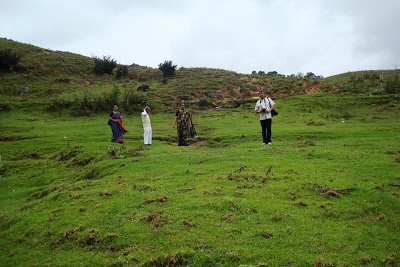
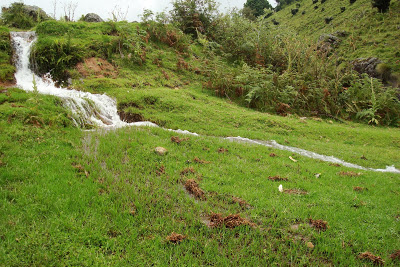
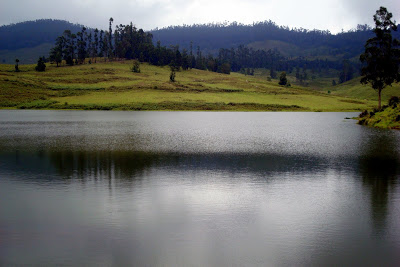


ha..this time I went to elephant valley..should check this out next year 🙂
This is beautiful!!! we have been to kodai twice, and the first time we went the usual tourist route! that was the first and last time i visited any ‘points’ on hill stations.. wish we had found this place then….if there is a next time,i shall surely go there..
Excellent post! I have visited similar looking villages while trekking from Kodai to Munnar, but have never got to see their agrarian side.
It is always an experience when you pay a visit to the not-so-touristy places….
Hi Lakshmi! Wonderful post! Loved the green, the lake and the carrots…
There is a weird post at Blogtrotter Two… Enjoy and have a great Sunday and a gorgeous week ahead!
Very green the place looks.
The thought of “green fabric laced with dense vegetation and the tall eucalyptus trees” is splendid and your pictures show that! This is beautiful Lakshmi.
Gorgeous photos and beautiful place.
Lovely post. The serene beauty is captivating. I have visited similar places when I was young but then I did not posses a digital camera to capture the beauty. All are stored in my brain but there is no USB connectivity!
its beautiful!!!
Kashmir Houseboats Vacation, Houseboats Srinagar, Kashmir Houseboats Tours, Holiday in Kashmir http://www.kashmirhouseboats.co.in
Holiday Packages, Honeymoon Packages in Kashmir, Holiday in Kashmir http://www.houseboatskashmir.com
sometime ago, as part of a highway project in Karnataka and tamil nadu , i had done lots of research on the nilgiris and the history & nature of the place just fascinated me…kodaikanal was one of the places i read in the books
since then, i have been wanting to go to the nilgiris, and particularly trek the Sullivan Trail
Such stunning beauty! Remarkably similar to Sri Lanka’s central hills too.
Hi Lakshmi!
After an odd post, Blogtrotter Two has a bit of Catalonia in Sardinia… 😉
Take pleasure in it and have a stunning week ahead!
PS: Thanks for your comment at the Orgosolo post. Please feel free to share it!!
hey , nice blog , like it ,
won’t be nice if i u can clickover to my blog page too ,
& post some suggestion
this is very greatful and informatic helpful Can I quote a post in your blog with the link to you? i want to book mark it.
Thanks
erajasthantourism
http://www.erajasthantourism.com/
rajasthan tour travelpacakeges,golden triangle india,
Luxury Rajasthan Tours
Nice blog for the traveling i also want go like this place. And I like these climates.
Thanks for sharing.
This place in great. Thanks for letting me get to know abt this new place. Loved it!! Would visit soon!!!
A visit to India Gate at night
A Stroll at the Bhudha Jayanthi Park
lovely . i m now planing to go
Beautiful post. I’m currently living in Chennai and especially after reading your post can not wait to get away to Kodikanal! As I was reading I was lost in the beauty of the nature you described so well. I think for just a brief moment I may have even blocked out the sounds and sights of busy Chennai, how refreshing!
Look forward to reading more of your adventures!
Wonderful blog!
I enjoyed reading your entries 🙂
outstanding pics! I feel like I was there!!
The mannavanur is just fresh in mind, as I visited it a year before. Its one of the most beautiful and pristine place in kodaikanal and I wish to go there again. The poombarai, on the way to mannavanur is also an awesome place to view from the roadside and there’s no word to describe the beauty when mist caress the village.
Nice post!
hi lakshmi,
your narration was awsome and pls keep posting like these. owuld you pleas let me know is it posible to reach munnar from mannavanur ..is there ant motorable road ..?..
regards
Selva
[email protected]
Burma is an amazing place. Lets hope political situation improves there so that we can visit without issues.
I also encountered same experience in 2008, when one employee at sterling resorts told about manavannur. next day i visited with a help of a local man. silence, calmness and beauty of the place is beyond our expectations.
i love u mannavanur
Very interesting post and amazing pictures. Would love to visit this place next time.